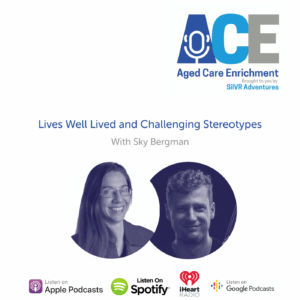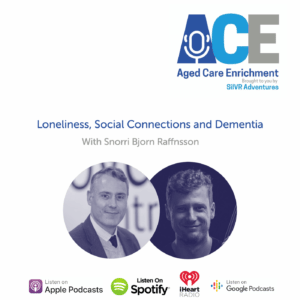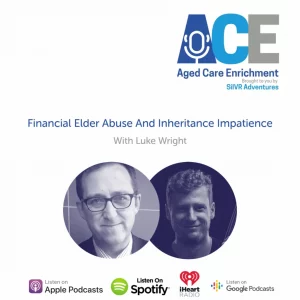This episode features Julianne Parkinson, CEO of the Global Centre for Modern Ageing (GCMA) a not-for-profit organization that allows businesses to co-design with seniors to develop better more desirable products.
In this episode Ash and Julianne discuss how the pandemic has affected the technology usage of seniors, how to smooth out the transitions between receiving care in the home and in a facility, and what a longer midlife might look like.
Transcript
Ash: All right, thank you so much for joining us Julianne on the podcast.
Julianne Parkinson: It is a pleasure to be here, Ash. Thank you.
Ash: Can we start with a bit of background about yourself?
Julianne Parkinson: Yes, certainly. I have lived all over Australia, I raised a family, and in my professional life, I have always been interested in how humans can be growing themselves as individuals, also how we can grow our economies and societies at the same time. While I have been living here in South Australia, we have been seeing this emergence of the importance of the ageing phenomenon, and what it meant to society here in Australia and overseas, and also what it could mean to business and governments if we were to understand people as we age and how we can make a difference by sharing that evidence-based understanding in ways that bring innovation and change to improve people’s lives throughout life’s course.
Ash: Fantastic. That sounds very linked to your work with the Global Centre for Modern Ageing. What is the Global Centre for Modern Ageing?
Julianne Parkinson: Well, the Global Centre for Modern Ageing is a not-for-profit organization, and we exist for the reasons I have just described to you, Ash. It is understanding the way in which people are changing the way they wish to live their lives in their sixties, seventies, eighties, nineties, and beyond, realizing that an extended longevity is part of life. But also understanding that we are not necessarily living better. And so, we want to bring evidence and understanding that allow and almost to be the conduit, I guess, as an organization with our research platform and our co-design capability that is internationally accredited to allow older people to work alongside research partners, entrepreneurs, organizations, not-for-profits, and governments, to imagine how they would like to live their life going forward and what products or services we should invent from this moment on. Be it adaptations of existing products or services, or brand-new ways of thinking that we bring to the market to allow people to have two things. A better choice, by the way, in which they decide how they will spend their day participating in life, contribute to society, and at the same time be supported, and the breadth of choices. So, improve the quality of the choices and the breadth of the choices, but all informed by the people who are wanting to live their lives differently.
Ash: Well, that is fantastic. That seems like an important element that can often be missing in the creation of new services and new products. Would you agree that the work of the Global Centre for Modern Ageing is primarily research-based?
Julianne Parkinson: We certainly use research and evidence to inform the basis of everything that we do. It is always co-designed with the older person at the forefront. With that said, we do appreciate that life is intergenerational, and humanity at its best is when it acts as a holistic community. So, we are not limited with the work that we do to purely older people, but it is the centricity of older people that we have at the forefront of our work. And with the emergence of the growing numbers of population both in Australia, ASEAN, and indeed globally, what better investment can we be making in society and in the economy than to get this right.
Ash: Absolutely. And just before we started recording, you were mentioning the life lab that you are heading down there today. What is the life lab?
Julianne Parkinson: Thank you. Well, the life lab is a set of processes and methodologies in a form of a physical place which allows us to have a safe independent platform to test and validate trial products and services that are existing and future ideas to inform better product development into the future. The life lab itself is a simulated studio which we have based at the Tonsley Innovation Precinct here in South Australia. It is one of the leading innovation precincts worldwide. Our research encouraged us to base that facility there so that we could support Australian entrepreneurs, governments, and citizens, to have a safe place to carry out trialling, testing, and validation, often as you would appreciate, Ash, where we need products to work is in real life settings. That is where life takes place. So, our work takes place in various forms, but the simulated studio which has cameras and sensors and allows us to store and record people’s nonverbal and verbal responses to the experiences they are having with a particular product or service or even the notion of a new product or service, to help inform that development. The Tonsley Precinct has innovation status which allows us to do some testing in a safe and well-governed way. But that it would not be allowed in a normally regulated spot. So, by way of example, four or five years ago, the Tonsley Innovation Precinct had autonomous vehicles being trialled there well before as we are seeing them trailed now in communities, townships, and cities. So, it is at the leading edge, if you like, to allow that innovation to accelerate through smart iterations of code design and development.
Ash: Awesome. So, this sounds like a lot of the co-designing opportunities are coming through the life lab.
Julianne Parkinson: Well, certainly, it is almost our front door. Be it via zoom meetings such as the one we are having today or teleconferences, and certainly face-to-face visits when we are in different years that are not as COVID influenced as right now. And we can theme the simulated studio. We have a fully working kitchen which allows us to not just imagine but work through the practicalities of working with food and its relationship to packaging, to the marketing, tools and equipment in the kitchen, that allow us to get on with living our lives independently. We are also able to theme the space entirely neutral and then create environments, a workplace of tomorrow, bedrooms of tomorrow, homes of tomorrow, doctor surgeries of tomorrow, and all sorts of spaces and places that reflect real life environments.
Ash: Well, it is exciting to imagine the potential of that sort of space and having a dedicated environment which you can try on new things in.
Julianne Parkinson: Well, absolutely. And one of the dedicated nuances of what we have is the night vision that we have with our cameras and sensors. So, as we know, people are wanting to live at home for as long as they can stay independent for as long as possible and to be supported as distinct to be cared for necessarily. And where support meets care, what is that transition? And then to full care, what does that look like? So, we are fascinated by the transition points that all of us go through as humans. Not that age is necessarily the reason we transition. Life events make us transition. The moment you trip and fall in, you are in a moon boot. The moment you have a newborn, you are navigating in a pram, or you are the grandmother navigating the pram. All those circumstances in life create changes where we need to adapt ourselves and hopefully with products or services that enable us to live the way we intend to. But this life lab with that space does provide a safe house, a well-governed house, an evidence-based house, to inform when we do conduct trials in real-life settings, what were some of the glitches that we might want to narrow down or avoid as a result of those early trials? So, it brings more confidence to the real-life trials, and it is certainly fabulous for our products that are in prototype stage. People are wanting to test and iterate all sorts of aspects. Be them technology enabled products or services, or raw training that might be given by a carer to a resident of an aged care home. There is no limit to the way in which we can utilize the space to inform the future.
Ash: To give the listeners an idea of the kinds of things that you can try on there, do you have any things that have been trialled recently in the life lab?
Julianne Parkinson: Oh, sure. We have had some fantastic projects. I think what is important here is the quality of the co-designer. So, it is the people who are part of our community. We have a Global Centre for Modern Ageing community of co-designers that are predominantly older people, but not only, who put their hands up to be parts of trials of varying types and persuasions. A terrific one that comes to mind was an entrepreneur who had created a physiotherapy rehabilitation device. At the time, it was designed for high-performance athletes to recover from injuries or sporting ailments and get back on field. It was to support them and their sports physiotherapist. This entrepreneur realized that there are a lot of older people on the planet than high-performance athletes. And if he were to take his product and adapt it through co-design process, what could be the possibilities? And that was a tremendous project to work through. In fact, what was most interesting when we ran that project through the life lab with the entrepreneur, their research partner, and also the co-designers themselves or the older people, he was fascinated as an entrepreneur to learn that he did not need to change too many aspects of his product at all. So, one of the things about our work is not always that you need to make excessive changes to things. What our platform does do though is provide the evidence and the confidence that the changes you make will be in line with the sorts of desires of the experience your ultimate end customer or end user would want. That is one example. And since then, that entrepreneur has shifted his business strategy, which is now, I believe, entirely focused on creating products and services for the older people market. So, he is now got more other projects in research and development. So, it sends a signal to Australian businesses about older people being an important consumer base, a wealth of importance, to clearly understand. And when you create products or services with those people helping you guide that direction of the development; the benefits can be numerous. It is almost too many to mention.
Ash: Yeah. It sounds like you guys are well positioned between policy and private enterprise and innovation. And, like you said, creating awareness that there is a market there for elder people to engage in products and that maybe there is more potential than originally thought. We are recording this interview in late August two thousand twenty, and there is this pandemic going on. I think the Global Centre for Modern Ageing has done quite a bit of research throughout the pandemic. Is that right, Julianne?
Julianne Parkinson: Oh, look. Unlike many others around the globe, we were concerned, and yet at the same time, fascinated by what the COVID-19 pandemic meant to people. And as an organization, we invested quite quickly in seeking to understand that in the context of Australians living at home. In fact, we have undertaken to date a study during COVID that has been running since March in sort of six or eight-week increments reaching over a between one thousand two hundred and one thousand three hundred people’s homes in Australia. Of people aged over the age of eighteen, Ash, as I said, we are interested in older people, but we love to see that in the context of how it is affecting society. We were keen to understand what has been changing for people during that time. As recently as I can think, our next report is due out by the end of this week. So, that will be the latest one. It is available on our website, publicly available, and all free to assist the society to understand. Some remarkable insights have come from that work.
Ash: Yeah. Can you give us a little teaser of some of the insights that you found?
Julianne Parkinson: Sure. Well, I think at the outset, it is fair to say that older people have shown resounding resilience during this period. Despite often being older people at the centre of the concern as we saw with the high-risk categories early on, and that has remained the case not only in one category clearly but concerning one that we needed to keep safe. Because one of the positive things we saw from that is that during the pandemic, through the eyes of people who completed the survey, they were buoyed by the community involvement. Outreached citizens gave to each other support and care whether it is your neighbour, the extended use of contacting friends and family and reaching out in ways that people did not normally take time for and have the mindfulness and thoughtfulness to do. So, they brought a great deal of confidence that this pandemic, as dire and as serious as it is, was bringing what we call a silver lining to the equation here in Australia.
Julianne Parkinson: Certainly, these stories are replicated as we have seen in use around the world and media. So, we are not limited to this good positive aspect of the response to COVID. What we also saw was this increase in the comfort and the use of technology. I can say that older people have been leading the charge in this regard. We found it so interesting that that formed the depth of our second form of inquiry where we wanted to understand what is happening behind the doors of people in the homes of respondents that had used Telehealth since the COVID outbreak. Eighty-four percent rated their overall Telehealth experience either the same or better than face-to-face consultations. So, this satisfaction was higher when Telehealth was with the respondents’ regular doctor though, but the overwhelming evidence was that people were comfortable with or found it the same or better than the ability to log on over eighty-five percent of cases, and the privacy that pertain to that from their perspective for their consults. They were with doctors, they were with Allied Health Specialists, there were some mental health visitations as well. Some of these were by phone, and some of them by video conference such as Zoom. It is fair to say that there was more uptake with phone than with video, but it is also fair to say that the confidence that came from the video conference and face-to-face was interesting.
Julianne Parkinson: Now, we know this was undertaken during a period where people were asked to stay home and not to get on buses and visit their hospitals. The surgeries were asking people to limit some of the visitations in person. So, we are also interested in understanding, as the pandemic may lift in the future, other health choices of creating or gaining your health care advice will be opened again. Where does Telehealth fit as a legitimate part in the blend that suits the patient their care and family members? And equally, the clinician or their health provider, because it is important that this technology platform serves both parties to make sure that the health care experience is the right one for the patient each time.
Ash: Yeah, I can see that there are a lot of opportunities now that you have some data on how Telehealth is being received. It seems like it could be reimagined with its position as a viable alternative to a face-to-face visit.
Julianne Parkinson: Well, it certainly can be a healthy alternative on the right occasions. But we would also acknowledge that there are times where it is not a replacement for the face-to-face visit. So, we are certainly not asking it to replace, but it could extend the offerings of the way in which people consume. Of course, regional listeners would be aware of this. Telehealth is pioneered out in the regions by the sake of necessity, I guess in the same vein, of the COVID restrictions that forced us to think about new frontiers even if your doctor’s surgery is a hundred fifty meters from your home, not one thousand five hundred kilometres from your home.
Ash: So, Julianne, another paper that the Global Centre released called “Ageing in the right place” found that eight out of ten people wanted to remain in their current home if possible. What are some challenges that arise through that?
Julianne Parkinson: Well, there is a near universal desire for people to age in their own homes wherever possible. It does not mean that they do not want to improve or refit and repurpose their home to make it meet those needs. But as we know, age is one determinant, but not the only one. There are many points and transitions in life as we mentioned earlier that trigger and signal the need to change maybe your physical place. But most people are not proactively modifying their homes in preparation. Most of the modifications occur under duress like after an accident or an incident. So, decisions can be rushed. There are opportunities for builders, designers, and architects to specialize in the provision of that home in the that growth sector of both people who are living independently at home, people living in residential villages, and people living in aged care societies or communities as well. What we saw that is important to people was a term that we coined while undertaking this research and finding the insights. It was the term of “House, home, and haven.” And that for many people, they have a pragmatic space that you might call your house, the physical form that provides you shelter and some levels of safety.
Julianne Parkinson: But over time, when we live in a space that becomes our own, we make our own experiences that we have in that home, the joy, sometimes the adversities, but it becomes more of a home that we have a collection of things around us that remind us of where we have been and where we are. And then, we can really transcend into a haven like space which is the sanctuary or the space in which we want to live. One of the things that happen through this large expensive project that we ran called “Ageing in the right place” was there were people explaining to us and providing insights that this notion of “House, home, and haven” can be in many forms. This was not a group of highly wealthy and privileged individuals, nor was it a group of socially and economically struggling individuals. It was a blend of people who responded to it. There were people who own their home, and there were people who rented their home, and we had no idea whether the people had mortgages or not. So, this was a primal response to how individuals would seek to live their life. We have been working with this research to try and support people who are responsible for creating the spaces and places in which we live to allow them to understand that not all of this is about large infrastructure spend. You can live in quite a grand place and have loneliness and isolation and not have a feeling of well-being. You can live in a far more modest dwelling and have that true tranquillity.
Julianne Parkinson: So, the essence of this is thoughtfulness and understanding of what the needs are for that person now and into the future, and how to assemble the support, the products, and the services in the form that allow us to have that. So, we use this work to illustrate the expansiveness of what is possible in areas where the product development industry has not quite gone before. But if we talk about ensuring that people have great places to live, participate in life, and engage throughout all of life’s course, this is definitely a growth in an undernourished sector to be understood and one that we would like to help inform. It is not just the space; it is the precinct and the areas around it. And so, that is where the community steps into the fray for this important conversation.
Ash: Yeah, you touched on something early in that there are a lot of decisions are made quickly and under duress in response to perhaps a fall or an incident, and that perhaps better decisions will be made if they are made proactively. Do you think that there needs to be a change in kind of the thinking around these changes so that it is more acceptable to think about home modifications before they become necessary?
Julianne Parkinson: Oh, absolutely. One hundred percent. This is part of life planning. And when we say that people often immediately go to life planning as meaning financial planning. But we see it more holistically than that. We do see the importance of understanding your wellness and your well-being agenda and what you are prepared and able to do to help self-regulate yourself and stay as well as you can. That is the best way to live a good life. It is to be preventative where possible, but of course we must consider the importance and the natural aspects that can come with chronic diseases as well as part of life as we age and other aspects. So, we want people to be assisted with ways to think through their life planning which takes into account the physical, the emotional, the spiritual, the intellectual, and the environmental, and then to help people form their futures going forward. That is why we are happy to be working with younger generations on proactive wellness initiatives as well. So, there is an intergenerational uplift. We are not only interested in the next few years, which of course is important to us, the commitment to citizens as they are ageing right now, but we have a long term vision that is decades into the future to be supporting people as they age throughout life’s course.
Ash: Well, yeah. It sounds like the scope is, as you said multiple times now, massive that you have an opportunity to change the way that people think about ageing and the way that people think about planning for their lives. It sounds like the steps that the Global Centre is putting in with younger generations are going to sow seeds for the future.
Julianne Parkinson: Well, we hope to be part of a much broader collaboration of the ecosystem to help make this happen. But absolutely, that is our intention. We always try to encourage intergenerational responses so we can think about aspects like mental wellness and well-being. We see some dramatic and alarming numbers and narratives happening for older people, but equally and unfortunately, there is no age determinant here. We see youth and youth suicide as increasing. How do we assemble the wisdom and the knowledge of older people to support younger people? These are leadership roles. This is not about older people always have been the recipient of other people’s care and support, though that is helpful, it is good if we are intergenerational in this, but it is also the leadership roles that we can play participating in life. Not to be taking leadership away from people. This is the time where they have got the most to offer. They have walked down this path longer than anyone else, and they have learned a lot on the way. Many are prepared to share their wisdom and their point of view. Many are seeking for someone wise to listen to. One of the aspects about improving people’s lives as we age is workforce engagement and volunteering. So, it is workforce engagement transitions. Society has so long have had this fixed term about retirement which really does not do many people justice if anyone at all.
Julianne Parkinson: How do we allow people to stay actively engaged in ways, paid and unpaid, that are meaningful and purposeful to that individual and to society? Too often from what we see at the Global Centre of Modern Ageing, the disconnect, the team product development of new products and services for people as consumers, rests in part because the organizations themselves do not have people of the age and the persuasion of the consumers are seeking to make. So, be it financial services where you have asked people to retire at a specific age, and yet your consumers are living well into their nineties and hundreds, if only we had more representation. So, we talk about diversity in the workplace. But the one that is least understood and the least spoken about is ageism. It permeates in a way that I think is dangerously pervasive to the way in which we view each other, and we shame our future selves when we talk about how we age. So, having an open door and freedom, their managements will think differently about the age diversity that we bring in alongside gender and race and the other important parts of the mix. I think we will do a lot for improving the way in which organizations naturally think about their consumer base in the future.
Ash: That is fantastic. If we jump back to the “Ageing in the right place” paper, there is another piece of evidence in here. Only five percent of surveyed respondents would consider moving into an aged care facility if they needed help. What do you think this says about aged care facilities, and what can age care providers do to address this?
Julianne Parkinson: Well, I think it is essentially more to do with one of those other most significant transitions in life. Where, as you mentioned earlier, these happen at times of a critical incident. And so, at some level as an individual, it is perhaps a grudge transition. Nobody necessarily walks towards wanting to have to do that.
Ash: Do you think there is a way to change the appreciation of aged care facilities from something that might have to happen into something that is exciting for people who are ageing?
Julianne Parkinson: I think it can be meaningful in many ways when it is done well, right? So, I think there are already examples of that. But what I think we are seeing is possibly the trend that people are wanting to stay at home for longer. So, I think what we will see is more of a growth in the ability to bring better products or services and adapt those homes accordingly to allow people to age in their own homes for longer than we have ever done before. And perhaps in some of the community settings as well allow to people to stay inside in settings with better products and services. Technology can also be part of helping to monitor our health in that regard, but not limited to that, it will be carers and services into the home. So, I think you will see a grow. I certainly am not suggesting that aged care and residential aged care is not playing a necessary role, it certainly plays an important role, but the improvements to it, I think, could be informed by some of the changes we are going to be seeing down the line a bit earlier as people are wanting to age at home.
Julianne Parkinson: So, I think there will be less linear progression there, and I also think that people will have moments and transitions where you might go into an area of supported care or a higher level of supported care, which we are already seeing in Australia for a period of time while you rehabilitate. And then you might return to your home. So, less of that linear gate that you are going through one gate of living into the next phase and then the next and then that is it. I think we will see a more fluid relationship, and that will be through the investment of providers, government, the organizations, and the entrepreneurs who are not operating in this space yet. But who will be in the future?
Ash: Yeah, thank you for that clarification. It shows that it does not need to be a binary situation between living in your home and living in a care facility, but the lines can be blurred. It can become grey areas, and we can take the best of both worlds by putting those aspects from the home into the aged care facility or aspects of care into the home and moving forward. It sounds like the research that the Global Centre has found supports that idea. That it is less of a cut and dry now that you are in a home. It is more of as you said, a fluid approach. What are some trends you are beginning to see a new products and services within the aged care industry or within the care industry for elderly Australians?
Julianne Parkinson: There is a lot of innovation. We will have application to both the home and in residential care as we spoke about earlier. That is our belief. For example, devices that collect health data and transmit it to a central point enabling artificial intelligence to identify the level of direct health care intervention required. Health care will be about the analysis pre-emptive management. The physical consultation when required, there are some exciting developments in assistive technologies and robotics for simply helping carers with things as important but as simple as the heavy lifting that is required in aged care. So, we are seeing it in Century, we will be seeing it in new food products and innovations, we will be seeing it in access and mobility, and to help people as was mentioned earlier, passive sensors to help monitor people’s wellness in the home to make sure that if others are not around, they are still in a good space so to speak.
Ash: We have covered so much stuff in this conversation. I just have one more question before we go. You have a quote that is front and centre on your LinkedIn page that says, “What if the great achievement of longevity is not a longer old age, but a longer midlife.” What does that quote mean to you?
Julianne Parkinson: Well, it means a lot to me. What I mean by it is that in our midlife, we give ourselves permission, and we give ourselves expectation. Just as we did in earlier stages of life, we set ourselves’ plans, we set ourselves goals. We set ourselves’ permission to make investment in ourselves to improve ourselves to make sure that our relationships are of the value and of the health, if I can use that term, that is rightful for both you and the other parties as part of those relationships. Be them in your personal lives or your professional lives. We invest in our wellness. We do not stop having aspiration around what our future could be. We realize that we bring our own efforts and our wherewithal to the table, and we can learn and grow to support those future endeavours.
Julianne Parkinson: We are mindful of how we should and could be supporting others who are in their midlife journey and wanting to develop themselves. I use it because the end of life is there for all of us. Life is there from the beginning to the destination of time in this form that we know. But that does not mean we cannot continue to grow and nurture ourselves and others alongside us. I would hate to think that at any point, a birthday or potentially a significant transition in our lives which are all going to happen if we continue to live, those things will not be taken off the table. They will happen into the future if we live. How do we still allow ourselves to grow, and importantly, look out around us and to see others around the globe to encourage them and support them to grow? So, I am taken by the wonderful models of people. I see people at eighty-nine showing an amazing midlife now. I see the way they invest in their friends, having their friends over, engaging and supporting their contacts, and continuing to learn in their own way. So, they share, they develop, and they extend what they know to others.
Julianne Parkinson: I was with somebody just on Saturday. I was watching the footy with her at her home. Eighty-nine years old and a glowing exemplar in my mind of a woman completely in the throes of her midlife, and therefore, that mindset allows that to happen. I think the end of life will come for us all. As it comes, we want to look back and say, “Did we give ourselves permission and did government and society around us support us in our decision to live the life we wanted to live on our terms and in our time?” I want that for everyone around the globe. I feel like that responsibility utterly rests with organizations like the Global Centre for Modern Ageing and many others like governments that are large or small, organizations that are large or small, not-for-profits, and humanity to get together to support the consciousness and the mindset of how powerful that can be.
Ash: Where can people find out more of all the things we have been talking about today?
Julianne Parkinson: We would love people to jump on our website at the www.gcma.net.au. Sign-up if you would like to receive GCMA research. Sign-up if you want to be a co-designer. We are fortunate that three thousand three hundred people have organically just joined us in the last couple of years. All these people are interested in two things. One, the curiosity to understand modern ageing better. And for many, the investment of changing the way they live to encourage a more inclusive future where older people are at the centre of all the positive that is ahead of us all.
Ash: Fantastic, Julianne. Thank you so much for your time today.
Julianne Parkinson: It is such a pleasure. Thank you.






